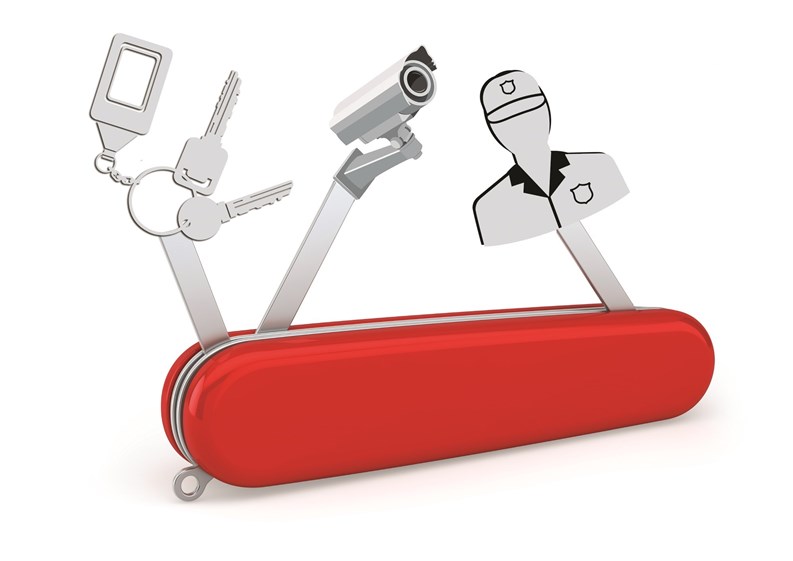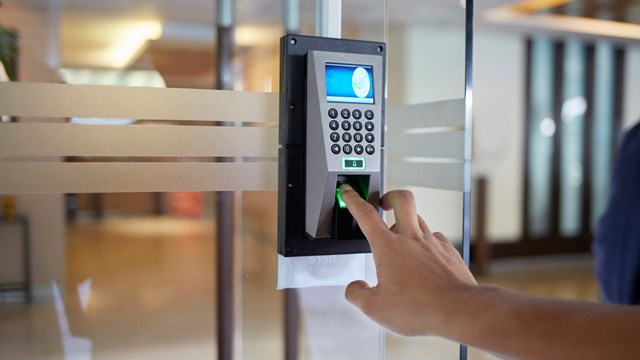The most important aspect of managing a building is keeping it, its residents, and their property safe. In days past, 'safety technology' consisted mostly of well-lit exits, the installation of panic bars and glow-in-the-dark stripping on exit doors.
Of course, in addition to getting residents out in case of emergencies, 'security technology' also means keeping potential troublemakers out. To accomplish this, many buildings were outfitted with cameras that captured grainy, time-lapse video recordings that managers hoped would deter unauthorized folks from coming into the building. Unfortunately, they didn’t really work. That's because fundamentally, cameras are just mechanical eyes. When it comes to security, their prime purpose is to record what happens in an environment for use later by the board, management, community security staff and possibly law enforcement if a problem is reported.
“Research shows that time-lapse videos did not deter criminals, but instead were only good in trying to solve crimes,” says Larry Dolin of American Security Systems in Long Island City, New York. “You could use closed circuit television to view around and into the premises, but a lot of people do not understand the criminal mentality. Criminals don't care if they are recorded.”
New Innovations – With Caveats
So how then does a community monitor its property and give residents peace of mind? Security technology has improved over the years to do just this. Gone are the grainy VCR recordings of yesterday. Today, instead, security technology is beginning to look more like science fiction. We aren’t traveling by flying cars, but getting in and out of buildings by using our faces or thumbprints instead of metal keys is definitely a reality.
Dolin remembers when the video intercom first came on the market. “Before then, the residents were letting people in by buzzer, but you couldn’t see them,” he says. “The video intercom was much better technology than what we had at the time. If there was a buzzer to let someone in, the intruder would just hit all of the buzzers until someone in some unit would let them in.”
“It’s pretty cool that we have an iris scanner now too,” says Ralph Jensen, editor-in-chief of Security Products magazine. “And there are fingerprint devices too. All of those things I enjoyed watching on The Jetsons are happening.”
“Over the years, security technology has advanced,” says Mark J. Lerner, Ph.D, criminologist and founder of EPIC Security Corp. in New York City. “The caveat is that you shouldn’t be overly impressed with the bells and whistles of the technology.”
Lerner explains that the often-used closed circuit technology, which records on a time lapse video, has undergone advancements. “The time-lapse is gone—now, like with televisions, there’s high-definition, and hard drives with more capacity,” he explains. “The closed circuit used to be able to hold a terabyte [of data], but now it can record much more, has much higher resolution and longer recording times. It used to be very grainy black-and-white, but now the recordings are in color and the resolution is much better. Plus you can zoom in.”
Dolin agrees, but adds that he “Recommends closed circuit television, but not as a substitute for security personnel.”
Who Goes?
Of particular interest to residential buildings, with their multiple entries (front door, laundry, common rooms, roof, etc.), is what experts call “key security;” the challenge of keeping emergency copies of owners’ apartment keys in a totally secure environment (so as to prevent employee theft or other unauthorized access) while at the same time providing quick emergency access 24/7. According to James Carlini, founder of Carlini & Associates, a Chicago-based consulting firm specializing in intelligent buildings and intelligent infrastructure. “Twenty-five years ago, there was no system at all for this, and now there are two: Keytrack and KeyLink. These are highly sophisticated lockbox biometrically-operated systems, uniquely used by residential high-rise buildings, auto-dealerships, and the U.S. military in Iraq.”
Controlling who has access to a building or development and its interior spaces is just as important as watching who is outside of the building. “Watergate is one of the most famous cases of someone getting into a building by overcoming access control,” says Lerner.
On the night of June 17, 1972, a security guard at the Watergate hotel in Washington, D.C. noticed a piece of duct tape stuck to a door lock to prevent the door from latching shut. “This still happens pretty routinely today,” says Lerner. “However, criminals do not go into places where they see a doorman or security guard.” A live guard also has the ability to sense something amiss and investigate—something a camera simply can't do.
That said, the cost of hiring a living doorman or security personnel can be prohibitive for many communities – particularly smaller condo buildings or HOAs who may be strapped for cash because of major capital projects or other necessary expenditures.
An option for these communities may be a so-called 'virtual doorman.' Though they go by different brand names, these services provide many of the features of a traditional doorman, in addition to video security, electronic access control and alarm monitoring “It means you connect through the power of the Internet,” says Dolin, who developed one service under the brand Video Doorman. “When the system is triggered, it’s brought to life. It would cost a smaller building a large amount of money to have a [live] doorman, so we created a system that included package delivery and made it totally interactive.”
“Everybody wants to live in a secure building, young women and seniors,” adds Carlini. “IPTV cameras—Internet Protocol television is very popular now in smart buildings. Once you put that into a building, it can switch to a channel on your TV and you can see who is at the door. This is a huge issue for security.”
Once the virtual doorman or IPTV system recognizes that someone is in the building, the visitor is then followed by camera. “More importantly, they are followed until they leave the building,” says Dolin. A virtual doorman can also be available to cover shifts on days when there is no human coverage, or can provide back-up when the live doorman leaves his station to perform other security duties.
Jensen says that the virtual doorman isn’t necessary new, but it does allow the visitor to only get so far in the building before someone is alerted to his or her presence. “Access cards for residents, however, have changed and are now available as apps on smart phones,” he says. “Just put your smart phone up to a reader on the door. I don’t even have to put my phone up. If I get close enough, the reader reads it.”
When it comes to the benefits of an access card app, Jensen says that if an access card or a regular key gets lost or stolen, the building has to go through the process of canceling the card. “Another pretty cool advancement is an iris scanner, which looks into your eyes and connects it to who you are,” he said. “There’s also biometrics and a fingerprint device to keep the building safe.”
Cost Savings
How do those costs differ from that of hiring a human doorman, or having full- or part-time security staff? “A doorman is 24 hours a day, 7 days a week, so that’s 720 hours,” says Dolin. “Even at $12 to $15 per hour, you’re talking about $115,000 and that’s a lot for small and moderate-sized buildings. We’re 5% of what a doorman costs, at about $12K to $15K per year.”
According to Jensen, the costs of the biometrics systems are coming down too, making it more affordable for smaller buildings. However, aside from saving money, a board/management team should also be interested in preserving the quality of life for its tenants.
“Some buildings need to work on loitering, vagrants and vandalism,” says Dolin. “Four minutes after hanging out in the building’s vicinity, the virtual doorman will come on and tell [an individual] they have to move, per management. It can dramatically change the profile of a building that may be struggling.”
Buildings with lots of working parents can benefit from another security feature of the virtual doorman, says Dolin. Every day, millions of kids return from school to an empty home because their parent or parents are away at work. “Once the child gets home and swipes their card, the parent will get notification that they are home,” says Dolin. “Interactive is the future in multifamily buildings.”
No matter what the security system is, Jensen says that none of them are foolproof. “A camera captures an image, but doesn’t stop anything,” he said, “If someone wants to get into a building bad enough, they will.”
And it's also important to remember that it's not enough to just furnish the appearance of security; you have to back it up. So while the sight of an unblinking mechanical eye can discourage some types of crime, it's still your duty to maintain those cameras with reasonable care.
Scott J. Eriksen, a partner in Perkins & Actil of Westford, Massachusetts, notes that “generally, there are no requirements to have security cameras in place — but there are cases out there across the nation that say if you’re going to put security measures in place, then you may have created an expectation of safety or security that could potentially subject you to liability down the line.”
With that in mind, he says, if an association installs security cameras, it’s important to make sure that the cameras work. “The board is not responsible for the actions of bad actors,” he says, but if criminal activity happens and unit owners thought there were security cameras recording the activity, “you may have exacerbated the situation.”
And boards should definitely not try to save money by giving a false appearance of security. “We would never tell clients to put in fake cameras, with signs saying the property is monitored by security cameras. If you do that, it could create an expectation of security, and arguably make the situation worse.”
While condominiums are not required to have cameras on site, if the community is in a high-crime area, management should want to know what’s going on so they can put a halt to any mischief. Put simply, residents don’t want to live in a high-crime area, and managers want people to occupy their homes in peace.
Most industry pros recommend that boards and management institute a layered approach to security. “It starts at the parking lot and then there’s access control at the door,” says Dolin. “Work from the outside in.” Different communities may have differing needs—more layers, in other words—but according to Dolin, “doing it that way is the basis of a good security plan.”
The last thing anyone wants is for someone in their building to become a tragic statistic. Instituting today’s security technology to help protect the building and its residents is not something that even needs to be discussed. It should be at the forefront of every building and every budget meeting. Prices of the Jetson-esque security technology is dropping, so including it in the budget today can save lives tomorrow.
Lisa Iannucci is a freelance writer, author and editor and a frequent contributor to New England Condominium.







Leave a Comment